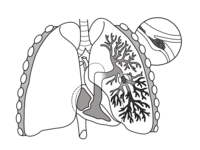
Photo from wikipedia
Pulmonary vein isolation (PVI) is the treatment of choice in patients (pts) with symptomatic atrial fibrillation. Durable pulmonary veins isolation (PVI) seems to be associated with a lower risk of… Click to show full abstract
Pulmonary vein isolation (PVI) is the treatment of choice in patients (pts) with symptomatic atrial fibrillation. Durable pulmonary veins isolation (PVI) seems to be associated with a lower risk of AF recurrence, but the predictor factors of persistent PVI are still uncertain. We aimed to determinate the predictor factors and the prognostic role of persistent pulmonary veins isolation in pts with arrhythmia recurrence necessitating a second ablation procedure. Our Study included 102 pts (65.7% male, 65±8 years old, 75.5% persistent AF) with arrhythmia recurrence, whom underwent a Redo-PVI between October 2016 and Mars 2018. Patients were divided into two groups regarding the persistence of PVI. Group 1 included 20 pts with persistent PVI and Group 2 included 82 pts with reconnection of at least one PV. The clinical profile, ablation data and three months arrhythmia recurrence were analyzed. There were no statistical differences in terms of clinical profile between the two groups of pts (age; p=0.513, gender; p=0.299, BMI; p=0.077, diabetes mellitus; p=0.621, coronary artery disease; p=0.787; arterial hypertension; p=0.732; left ventricle ejection fraction; p=0.323 and left atrial diameter; p=0.5). Patients in group 1 presented more often with atrial tachycardia compared to group 2 Patients (30% versus 7.3%; p=0.014). Regarding the ablation data, there were no differences between the two groups in terms of procedure time (p=0.710) but the ablation time was longer in group 2 patients (29.1±13.7 versus 20.8±10.5 min. p=0.031). Low voltage areas (LVA) acquired by bipolar electroanatomical mapping were more often and diffuse in group 1 patients (70% versus 40.3%; p=0.050). The three months arrhythmia recurrence after Redo-Ablation was the same between the two groups (p=1.000). The type of arrhythmia recurrence and low voltage areas are predictor factors of persistent pulmonary veins isolation in patients with arrhythmia recurrence necessitating a second ablation procedure. This fact can help in planning the second ablation procedure. Persistent PVI seems to have no prognostic role regarding the three months arrhythmia recurrence after Redo-Ablation.
Journal Title: European Heart Journal
Year Published: 2019
Link to full text (if available)
Share on Social Media: Sign Up to like & get
recommendations!